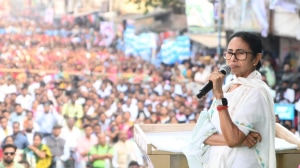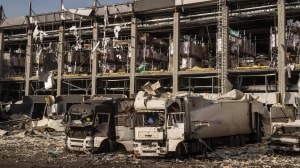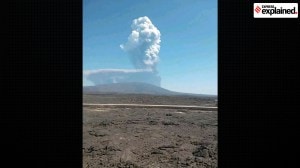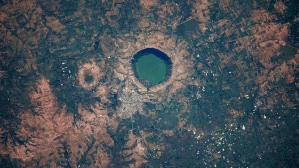What the International Stabilization Force for Gaza, proposed by Trump, envisages
While both Israel and Hamas announced their acceptances of the ceasefire and its associated obligations, concerns remain over larger peace plan for Gaza and the long-term fate of Hamas in Palestine
 President Donald Trump greets Prime Minister Benjamin Netanyahu of Israel outside the West Wing of the White House in Washington, on Sept. 29, 2025. (NYT)
President Donald Trump greets Prime Minister Benjamin Netanyahu of Israel outside the West Wing of the White House in Washington, on Sept. 29, 2025. (NYT)There are two parts to US President Donald Trump’s 20-point ‘Comprehensive Plan to End the Gaza Conflict’, released on September 29. The first is an immediate ceasefire with both Hamas and Israel releasing Israeli and Palestinian captives. The second, into which the first is built, is a larger peace plan for Gaza and the long-term fate of Hamas in Palestine.
Both Israel and Hamas have announced their acceptances of the ceasefire and its associated obligations. It is the second part, where Israel, Hamas, Arab states, as well as the US show contradictory readings vis-à-vis Israel’s military withdrawal from Gaza, Hamas’ disarmament and future role, and the question of an International Stabilization Force (ISF) for Gaza.
The ISF, which the US will work to develop, “with Arab and international partners” is supposed to form the “temporary” but “long term internal security” component of a technocratic apolitical Palestinian committee that is authorized for “temporary transitional governance”. The committee will be overseen by a “Board of Peace” chaired by Trump. The ISF is sought to be deployed “immediately” in the “terror free areas handed over from the IDF (Israeli Defense Forces) to the ISF.”
But what kind of a force will the ISF be? How have such forces performed elsewhere? What are the challenges in Palestine?
What is the ISF’s envisioned character?
Any international peacekeeping or stabilisation force that has been traditionally deployed to assist with security sector reform or the disarmament and demobilisation of armed groups has one significant component.
In the absence of effective state authority (or hostility from any group, force, militia), the legitimacy of such a force is established through a mandate issued by the UN Security Council. Such UN authorisation is crucial, given its inherent neutrality and alignment with international law.
In cases where a UN force faces armed threats that hinder its mission objectives, the authorisation to use force is also governed by the UNSC through powers under Chapter VII of the UN Charter. Consequently, earlier calls for an international force in Palestine by other actors have all deemed the UN’s involvement imperative.
In May 2024, the Arab League’s Bahrain Declaration had called for a United Nations international protection and peacekeeping force “in the occupied Palestinian territory until the two-state solution is implemented.” By August 2025, Palestine’s Ambassador to the UN also called for a similar force as “immediate international intervention to stop the genocide”.
However, the ISF is not expected to function as a UN-mandated peacekeeping force by the White House. The UN’s role is restricted to aid distribution in Trump’s plan.
Apart from training Palestinian law enforcement, the ISF has two core functions – to set “standards, milestones, and timeframes linked to demilitarization” for Israel’s phased and partial military withdrawal from Gaza, and to ensure the continued disarmament of Hamas by blocking the entry of all munitions.
Apart from the lack of timelines for the ISF’s formation and deployment, the force lacks systems of accountability under the UN flag.
In the past, Arab diplomats have consistently maintained that Arab forces will not participate in an international deployment in Palestine, which is not under the UN’s Department of Peacekeeping.
Given the overbearing alignment of the ISF with American and Israeli objectives in Gaza, the force’s outlook and operations will ultimately be determined by the Trump-led Board until the Palestinian Authority is deemed sufficiently reformed.
How have such forces performed outside Palestine?
A UN peacekeeping, observer, or stabilisation force is usually established and deployed in areas where a certain threshold of political resolution has been reached (or is underway) to ensure that the force will not face combat.
Across recent decades, the rise of protracted intra-state wars featuring armed non-state actors resisting interventions/invasions by other states has shown that the absence of political resolution only worsens conditions for an international force, even those where an external organisation (such as NATO) has taken over operational command of UN-authorised missions.
For example, in Afghanistan, NATO undertook the responsibility for the International Stabilization Assistance Force (ISAF) in 2003, after it was established by UNSC Resolution 1386 in 2001. Beyond security sector reform in Afghanistan, ISAF’s mission soon ballooned into protecting territory through combat deployments against the Taliban. Both the ISAF and its successor (NATO-led Resolute Support Mission) ultimately failed in their strategic objectives, with the Taliban successfully displacing the government in Kabul in 2021.
Earlier, in Lebanon in 1982, a four-nation Multinational Force led by the US, Britain and France was created outside the UN framework, to oversee the withdrawal of the Palestine Liberation Organization from the country amidst Israel’s invasion of Lebanon in 1982. Even as the MNF deployed amidst apparent conditions of political resolution (after two ceasefire agreements) and was also charged with training the Lebanese Armed Forces, it was soon bogged down in fighting multiple militias as hostilities resumed in Lebanon. This resulted in the MNF withdrawing completely by 1983 and partially transferring responsibilities to the existing UN Interim Force in Lebanon (formed in 1978, by UNSC Resolutions 425 and 426).
Arab states would be keen to avoid such a situation in Gaza, and keener still to avoid fighting directly.
What are the challenges in Palestine?
In Palestine, the need for UNSC authorisation was recognised prior to Trump’s announcement of the 20-point plan. Former British premier Tony Blair (also part of the Board) recommended that Gaza’s transitional authority be established by a UNSC Resolution. However, Israel has historically viewed UN troops as hostile; Israel’s continued occupation of parts of Lebanon (for example) occurs despite the UNIFIL’s opposition. This, along with Trump’s own aversion to the UN, has ensured a minimal UN role in the ISF or transitional authority.
Moreover, in Palestine, there are no on-ground conditions which indicate political resolution (through a complete implementation of the two-state solution). All extant UNSC resolutions for Palestine overbearingly create obligations for Israel to end its illegal occupation. Without such withdrawal, there has never been a foundational UNSC Resolution to establish a peacekeeping force in Gaza or the West Bank.
Two elements in particular make the ISF’s deployment challenging. Israel has refused a full withdrawal from the Strip (which Trump has accepted), and Hamas has not committed to disarm or remove itself from the “comprehensive Palestinian national framework” in which it looks to contribute instead “with full responsibility”. Ensuring a full Israeli withdrawal as well as Hamas’s complete removal from Gaza have been cardinal conditions for either party across the years.
The lack of a full Israeli withdrawal in Trump’s plan also implies that splinter Palestinian groups might continue armed resistance to occupation, increasing the risk of combat/armed confrontation for any international force. It is this risk which exponentially increases the costs of Arab states directly involving themselves with the ISF, regardless of the vague mention of a “deconfliction mechanism” (presumably between the IDF and ISF) in Trump’s plan.
Arab officials from multiple states maintain that Trump’s publicly released plan differs from their versions, and an eight-nation Arab/Islamic joint statement on September 30 called for “full Israeli withdrawal”, significantly differing from the White House’s announcement and Trump’s plan, which retains Israel’s right to maintain a security buffer.
Netanyahu has also firmly ruled out a complete IDF withdrawal (a political necessity for his far-right allies who have rejected Trump’s plan outright). This discrepancy is crucial. It exacerbates Palestinian, Arab, and international apprehensions that the ISF might be seen as legitimising Israel’s occupation of Palestinian territories.
Consequently, global support for Trump’s “peace” plan is driven more by the immediate and urgent need for ending Israel’s war (characterised as a genocide by an independent UN commission), rather than an unconditional alignment with the plan’s details, including the ISF and its composition. The questions of long term peace, are left to further negotiations.



- 01
- 02
- 03
- 04
- 05



































